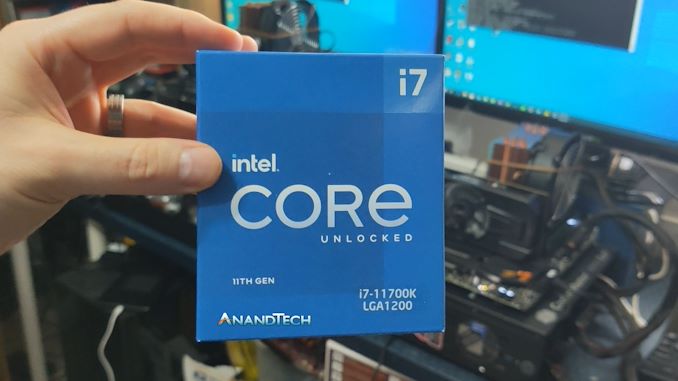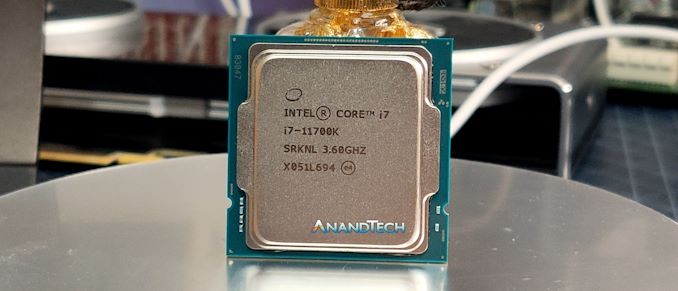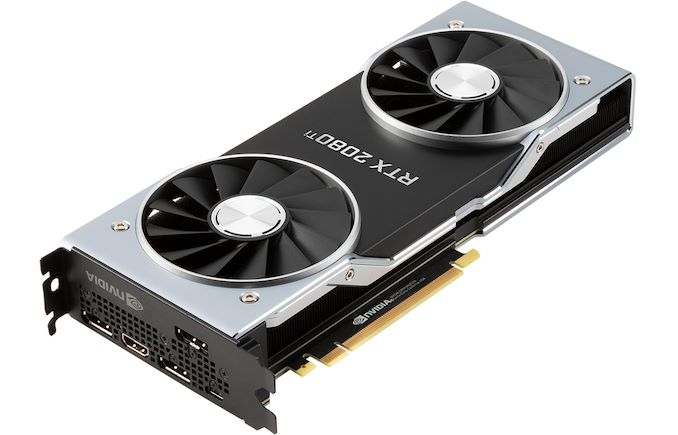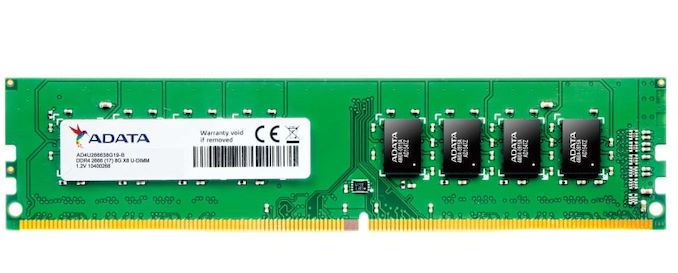Intel Rocket Lake (14nm) Review: Core i9-11900K, Core i7-11700K, and Core i5-11600K
by Dr. Ian Cutress on March 30, 2021 10:03 AM EST- Posted in
- CPUs
- Intel
- LGA1200
- 11th Gen
- Rocket Lake
- Z590
- B560
- Core i9-11900K

Today is the official launch of Intel’s 11th Generation Core processor family, given the internal name ‘Rocket Lake’. Rocket Lake showcases new performance gains for Intel in the desktop space, with a raw clock-for-clock performance uplift in a number of key workloads.
In order to accomplish this, Intel has retrofitted its 10nm CPU and GPU designs back to 14nm, because only 14nm can achieve the frequency required. In exchange, the new processors to get this performance run hot, cost more for Intel to produce, have two fewer cores at the high end, but customers also get PCIe 4.0 on Intel’s mainstream desktop platform for the first time.
In our review today, we will be going over Intel’s new hardware, why it exists, and how it performs, focusing specifically on Intel’s new flagship, the Core i9-11900K, which has eight cores and can boost up to 5.3 GHz
Intel’s Rocket Lake: Core i9, Core i7, and Core i5
The new Intel 11th Gen Core desktop processor family will start with Core i5, with six cores and twelve threads, through to Core i7 and Core i9, both with eight cores and sixteen threads. All processors will support DDR4-3200 natively, and offer 20 PCIe 4.0 lanes in supported motherboards – these lanes will enable graphics and storage direct from the processor, typically in an x16/x4 or x8/x8/x4 combination.
Both the Core i9 and Core i7 this time around have the same core count - normally the Core i9 would offer an obvious difference, such as more cores, but for this generation the difference is more subtle: Core i9 will offer higher frequencies and Thermal Velocity Boost (TVB). The Core i9-K and i9-KF will also feature Intel’s new Adaptive Boost Technology (ABT). We’ll go over Intel’s Turbo nomenclature later in the article.
| Intel 11th Gen Core Rocket Lake Core i9 |
|||||||
| AnandTech | Cores Threads |
Base Freq |
1T Peak |
nT Turbo |
TDP (W) |
IGP UHD |
Price 1ku |
| i9-11900K | 8 / 16 | 3500 | 5300 | 4700 | 125 | 750 | $539 |
| i9-11900KF | 8 / 16 | 3500 | 5300 | 4700 | 125 | - | $513 |
| i9-11900 | 8 / 16 | 2500 | 5200 | 4600 | 65 | 750 | $439 |
| i9-11900F | 8 / 16 | 2500 | 5200 | 4600 | 65 | - | $422 |
| i9-11900T | 8 / 16 | 1500 | 4900 | 3700 | 35 | 750 | $439 |
At the top of the stack is the Core i9-11900K. Intel has set the 1000-unit pricing of the Core i9-11900K at $539. Note that Intel does this 1k unit pricing for OEMs, and the final retail price is often $10-$25 higher, but in the case of the Core i9-11900K, users are currently looking at a $615 price point at Newegg. This is well above AMD’s Ryzen 7 5800X at $449 SEP (MSRP), which is also an 8-core processor, and beyond even the Ryzen 9 5900X at $549 SEP. Intel is stating that along with better gaming performance, this processor also offers next-generation integrated graphics, support for new AI instructions, and enhanced media support for the price differential.
The Core i9-11900K is the highlight processor of today’s review, and it has a base frequency of 3.5 GHz, alongside a peak turbo of 5.3 GHz in Thermal Velocity Boost mode, 5.2 GHz otherwise on the favored core, or 5.1 GHz on non-favored cores. The all-core frequency is 4.8 GHz in TVB turbo mode, or 4.7 GHz otherwise, or it can ‘float’ the turbo up to 5.1 GHz when ABT is enabled, however ABT is disabled by default.
The only processor not getting TVB in the Core i9 family is the i9-11900T, which is the 35 W member of the family. This processor has 35 W on the box because its base frequency is 1.5 GHz, although it will turbo up to 4.9 GHz single core and 3.7 GHz all-core. These T processors typically end up in OEM systems and mini-PCs which are more likely to strictly follow Intel’s turbo recommendations.
All Core i9 processors will support DDR4-3200, and the specification is to enable a 1:1 frequency mode with the memory controller at this speed.
| Intel 11th Gen Core Rocket Lake Core i7 |
|||||||
| AnandTech | Cores Threads |
Base Freq |
1T Peak |
nT Turbo |
TDP (W) |
IGP UHD |
Price 1ku |
| i7-11700K | 8 / 16 | 3600 | 5000 | 4600 | 125 | 750 | $399 |
| i7-11700KF | 8 / 16 | 3600 | 5000 | 4600 | 125 | - | $374 |
| i7-11700 | 8 / 16 | 2500 | 4900 | 4400 | 65 | 750 | $323 |
| i7-11700F | 8 / 16 | 2500 | 4900 | 4400 | 65 | - | $298 |
| i7-11700T | 8 / 16 | 1400 | 4600 | 3600 | 35 | 750 | $323 |
The Core i7 family includes the Core i7-11700K, which we have already reviewed with our retail sample, and tested on the latest microcode to date. This processor offers eight cores, sixteen threads, with a single core turbo of 5.0 GHz on the favored core, 4.9 GHz otherwise, and 4.6 GHz all-core turbo. The rated TDP is 125 W, although we saw 160 W during a regular load, 225 W peaks with an AVX2 rendering load, and 292 W peak power with an AVX-512 compute load.
On the topic of memory support, the Core i7 family does support DDR4-3200, however Intel’s specifications for Rocket Lake are that any non-Core i9 processor should run at a 2:1 ratio of DRAM to memory controller by default, rather than 1:1, effectively lowering memory performance. This creates some segmentation between Core i9 and the rest, as for the rest of the processors the fastest supported 1:1 memory ratio is DDR4-2933. Despite this technical specification, we can confirm in our testing of our Core i7-11700K that all the motherboards we have used so far actually default to 1:1 at DDR4-3200. It would appear that motherboard manufacturers are confident enough in their memory designs to ignore Intel’s specifications on this.
On pricing, the Intel Core i7-11700K is $399, which is important in two ways.
First, it is $140 cheaper than the Core i9-K, and it only loses a few hundred MHz. That leaves the Core i9 high and dry on day one. Unless there’s something special in that chip we haven’t been told about that we have to discover come retail day on March 30th, that’s a vast pricing difference for a small performance difference.
Second is the comparative AMD processor, the Ryzen 7 5800X, which has 8 cores and has a $449 SEP. If both processors were found at these prices, then the comparison is a good one – the Ryzen 7 5800X in our testing scored +8% in CPU tests and +1% in gaming tests (1080p Max). The Ryzen is very much the more power-efficient processor, however the Intel has integrated graphics (an argument that disappears with KF at $374). It will be interesting to see what recommendations people come to with that pricing.
| Intel 11th Gen Core Rocket Lake Core i5 |
|||||||
| AnandTech | Cores Threads |
Base Freq |
1T Peak |
nT Turbo |
TDP (W) |
IGP UHD |
Price 1ku |
| i5-11600K | 6 / 12 | 3900 | 4900 | 4600 | 125 | 750 | $262 |
| i5-11600KF | 6 / 12 | 3900 | 4900 | 4600 | 125 | - | $237 |
| i5-11600 | 6 / 12 | 2800 | 4800 | 4300 | 65 | 750 | $213 |
| i5-11600T | 6 / 12 | 1700 | 4100 | 3500 | 35 | 750 | $213 |
| i5-11500 | 6 / 12 | 2700 | 4600 | 4200 | 65 | 750 | $192 |
| i5-11500T | 6 / 12 | 1500 | 3900 | 3400 | 35 | 750 | $192 |
| i5-11400 | 6 / 12 | 2600 | 4400 | 4200 | 65 | 730 | $182 |
| i5-11400F | 6 / 12 | 2600 | 4400 | 4200 | 65 | - | $157 |
| i5-11400T | 6 / 12 | 1300 | 3700 | 3300 | 35 | 730 | $182 |
The Core i5 spreads out a lot with more offerings, from $157 for the Core i5-11400F, up to $262 for the Core i5-11600K. All these processors have six cores and twelve threads, all have the traditional Intel Turbo 2.0, and all support DDR4-3200 (2:1) or DDR4-2933 (1:1).
Another difference within these parts is that the Core i5-11400 and Core i5-11400T have UHD Graphics 730, not 750, which means using a 24 EU configuration rather than the full 32 EUs.
Intel’s Competition: Intel vs Intel vs AMD
With both the Core i9 and the Core i7 being eight cores and sixteen threads, the natural competitor to both would be either (a) Intel’s previous generation of processors or (b) AMD’s Ryzen 7 5800X, which is starting to come back into the market with sufficient stock that it can be purchased at its suggested retail price.
| Rocket Lake Competition | |||||||
| AnandTech | Core i7 10700K |
Core i9 10900K |
Core i7 11700K |
Core i9 11900K |
Ryzen 7 5800X |
Ryzen 9 5900X |
|
| uArch | Comet Lake |
Comet Lake | Cypress Cove |
Cypress Cove |
Zen 3 | Zen 3 | |
| Cores | 8 C 16 T |
10 C 20 T |
8 C 16 T |
8 C 16 T |
8 C 16 T |
12 C 24 T |
|
| Base Freq | 3800 | 3700 | 3600 | 3500 | 3800 | 3700 | |
| Turbo Freq | 5100 | 5200 | 5000 | 5300 | 4800 | 4800 | |
| All-Core | 4700 | 4900 | 4600 | 4800 | ~4550 | ~4350 | |
| TDP | 125 W | 125 W | 125 W | 125 W | 105 W | 105 W | |
| IGP / EUs | Gen 9, 24 | Gen 9, 24 | Xe-LP, 32 | Xe-LP, 32 | - | - | |
| L3 Cache | 16 MB | 20 MB | 16 MB | 16 MB | 32 MB | 64 MB | |
| DDR4 | 2 x 2933 | 2 x 2933 | 2 x 3200 | 2 x 3200 | 2 x 3200 | 2 x 3200 | |
| PCIe | 3.0 x16 | 3.0 x16 | 4.0 x20 | 4.0 x20 | 4.0 x24 | 4.0 x24 | |
| MSRP | $387 | $499 | $399 | $539 | $449 | $549 | |
| Retail | $322 | $470 | $419 | $614 | $449 | $549 | |
As we saw in our Core i7-11700K review, at $399/$419, the Ryzen 7 5800X at $449 is actually a good comparison point. On high-end gaming both processor performed the same, the AMD processor was ahead an average of 8% on CPU workloads, and the AMD processor came across as a lot more efficient and easy to cool, while the Intel processor scored a big lead in AVX-512 workloads. At the time of our review, we noted that stock of AMD’s Ryzen 5000 processors would be a large part of the choice between the two processors, given that stock was low and highly volatile. Since then, as in our latest CPU Guide, stock of the AMD CPUs is coming back to normal, so then it would come down to exact pricing differences.
If we focus on the Core i9-11900K in this comparison, given the small differences between itself and the Core i7, you would also have to pit it against the AMD Ryzen 7 5800X, however at its $539 tray price and $615 Newegg price, it really has to go against the 12-core Ryzen 9 5900X, where it loses out by 50% on cores but has a chance to at least draw level on single thread performance.
Test Setup and #CPUOverload Benchmarks
As per our processor testing policy, we take a premium category motherboard suitable for the socket, and equip the system with a suitable amount of memory running at the manufacturer's maximum supported frequency. This is also run at JEDEC subtimings where possible. Reasons are explained here.
| Test Setup | |||||
| Intel Rocket Lake |
Core i9-11900K Core i7-11700K Core i5-11600K |
ASUS Maximus XIII Hero |
0610/ 0703** |
TRUE Copper + SST* |
ADATA 4x32 GB DDR4-3200 |
| Intel Comet Lake |
Core i9-10900K Core i7-10700K |
ASRock Z490 PG Velocita |
P1.50 | TRUE Copper + SST* |
ADATA 4x32 GB DDR4-2933 |
| Intel Coffee Refresh |
Core i9-9900KS Core i9-9900K |
MSI MPG Z390 Gaming Edge AC |
AB0 | TRUE Copper +SST* |
ADATA 4x32GB DDR4-2666 |
| Intel Coffee Lake |
Core i7-8700K | MSI MPG Z390 Gaming Edge AC |
AB0 | TRUE Copper +SST* |
ADATA 4x32GB DDR4-2666 |
| AMD AM4 |
Ryzen 9 5900X Ryzen 7 5800X Ryzen 7 4750G |
GIGABYTE X570I Aorus Pro |
F31L | Noctua NHU-12S SE-AM4 |
ADATA 2x32 GB DDR4-3200 |
| GPU | Sapphire RX 460 2GB (CPU Tests) NVIDIA RTX 2080 Ti FE (Gaming Tests) |
||||
| PSU | Corsair AX860i | ||||
| SSD | Crucial MX500 2TB | ||||
| *TRUE Copper used with Silverstone SST-FHP141-VF 173 CFM fans. Nice and loud. **0703 was applied for stability support |
|||||
We must thank the following companies for kindly providing hardware for our multiple test beds. Some of this hardware is not in this test bed specifically, but is used in other testing.
| Hardware Providers for CPU and Motherboard Reviews | |||
| Sapphire RX 460 Nitro |
NVIDIA RTX 2080 Ti |
Crucial SSDs | Corsair PSUs |
 |
 |
 |
|
| G.Skill DDR4 | ADATA DDR4 | Silverstone Coolers |
Noctua Coolers |
 |
 |
 |
|
A big thanks to ADATA for the AD4U3200716G22-SGN modules for this review. They're currently the backbone of our AMD testing.
Users interested in the details of our current CPU benchmark suite can refer to our #CPUOverload article which covers the topics of benchmark automation as well as what our suite runs and why. We also benchmark much more data than is shown in a typical review, all of which you can see in our benchmark database. We call it ‘Bench’, and there’s also a link on the top of the website in case you need it for processor comparison in the future.
Table Of Contents
- Rocket Lake Product List
- Why Rocket Lake Exists: Retrofitting 10nm to 14nm
- Motherboards and Overclocking Support
- New Turbo Features: Adaptive Boost Technology
- Power Consumption and Stability
- CPU Microbenchmarks
- CPU Testing
- Gaming Testing
- Conclusion














279 Comments
View All Comments
SystemsBuilder - Tuesday, March 30, 2021 - link
Honestly, I think they just mislabeled the 11900k and 11700k in the first 3D Particle Movement v2.1 tests result OR it's thermal throttling because they are exactly the same but architecturally (11900k higher frequencies).But the whole topic of AVX512 is interesting. It looks like Intel did not release Cypress Cove AVX-512 architecture details like they did for Sunny Cove last year (and Skylake-X cores before). But if Cypress Cove is close enough to Sunny Cove (and tit should be), they have crippled the AVX-512 quite severely but to confirm that we need to see the official Intel slides on core design. I am specifically talking about that core port 5 is crippled in Sunny Cove (compared to what Skylake-X and Cascade lake-X have) and does not include a FMA, essentially cutting the throughput in half for FP32 and FP64 workloads. Port 5 do have a ALU so Integer workloads should be running at 100% compared to Skylake-X. I really like to see Cypress Cove AVX-512 back end architecture design at the port level from Intel to understand this better though.
GeoffreyA - Tuesday, March 30, 2021 - link
I believe they added an FMA to Port 5, and combining that one and the FMA from Port 0, create a single AVX512 "port," or rather the high- and low-order bits are dispatched to 5 and 0.https://www.anandtech.com/show/14514/examining-int...
https://en.wikichip.org/w/images/thumb/2/2d/sunny_...
GeoffreyA - Tuesday, March 30, 2021 - link
I'm not fully sure but think Cypress is just Willow, which in turn was just Sunny, with changes to cache. Truly, the Coves are getting cryptic, and intentionally so.SystemsBuilder - Tuesday, March 30, 2021 - link
The official intel slide posted on this page: https://www.anandtech.com/show/14514/examining-int... (specifically this slide: https://images.anandtech.com/doci/14514/BackEnd.jp... , shows what i'm talking about. The 2nd FMA is missing on port 5 but the ALU is there - 50% of FP compute power vs. Skylake-X architecture. The other slide on wikichip is contradicting official intel slide OR it only applies to server side with full Sunny Cove enabled (usually the consumer client side version is a cut down).In any case these slides are not Cypress Cove so the question remains what have they done to AVX-512 architecture port 0+1 and port 5.
GeoffreyA - Tuesday, March 30, 2021 - link
You're right. I didn't actually look at the Intel slide but was basing it more on the Wikichip diagram and Ian's text. Will be interesting if we can find that information on Cypress C.JayNor - Tuesday, March 30, 2021 - link
"My main interest is getting the fastest single-core AVX available..."Rumors within the last week say there will be Emerald Rapids HEDT chips next yr. Not sure about Ice Lake Server workstation chips. If either of these provide dual avx512 they might be worth the wait.
SystemsBuilder - Tuesday, March 30, 2021 - link
I'm thinking Sapphire Rapids, which is due to arrive in late 2021 (very best case or, more likely, 2022), is the one to hold out for. Build on the better performing 10nm Finfet, it will add PCIe 5.0, DDR5 and further improve on AVX 512 with BF16 and AMX Advanced Matrix Extensions https://fuse.wikichip.org/news/3600/the-x86-advanc...Now, if you read about this you realize what step up for (FP and int) compute that is. Massive!
scan80269 - Tuesday, March 30, 2021 - link
It looks like Rocket Lake is the first desktop class x86 processor to support hardware acceleration for AV1 video format decode, similar to Tiger Lake for mobile. Interesting how this power hungry processor family can deliver good energy efficiency when it comes to watching 4K HDR movies/videos. OTT platform providers need to offer more content encoded in AV1, though.Hifihedgehog - Tuesday, March 30, 2021 - link
Meh... This is a fixed-function IP block for a very specific task so it is going to be low power. At this point, for most people, HEVC support is what actually matters. HEVC already offers a 50% improvement in bitrate efficiency over H.264, and AV1 only claims the same thing. Royalties or not, because HEVC was first to the game, it became the industry standard for UHD/4K Blu-ray. Timing is everything and AV1 missed the boat on that by about five years. So with the industry locked into HEVC, AV1 is going to have an incredibly hard time getting uptake outside of online streaming, which is a whole other ball of wax. And even then, as a content creator, you can use HEVC royalty free anyway if you are livestreaming on YouTube.GeoffreyA - Tuesday, March 30, 2021 - link
While AV1's quality is excellent, surpassing that of HEVC, its encoding speed is impractical for most people,* and I'm doubtful whether it's going to get much better. If people (and pirates, yes) can't use it easily, its spread will be limited. The only advantage it has, which I can vouch for anecdotally, is superior quality to HEVC. But even this advantage will be short lived, once VVC enters the fray in the form of x266. I've got no idea how x266 will perform, but from testing the Fraunhofer encoder, saw that VVC and AV1 are in the same class, VVC being slightly ahead, sharper, and faster.* libaom, the reference encoder. Intel's SVT-AV1 is faster but has terrible quality.